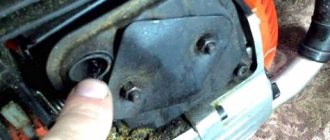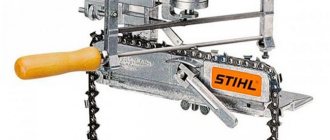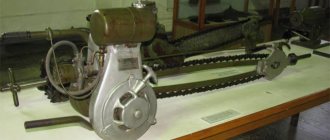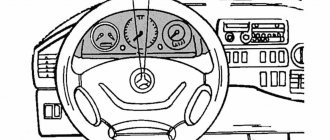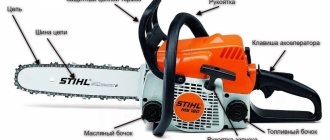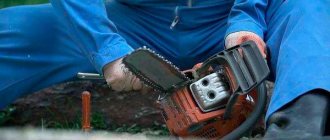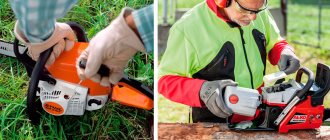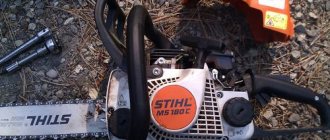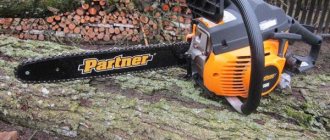One of the most unpleasant phenomena is when you are about to cut down a tree, but the chainsaw does not start. Many people encounter this phenomenon, not only owners of cheap Chinese chainsaws, but also branded professional tools. If you are faced with a situation where the chainsaw engine does not start, then do not rush to return the tool for repair. Simple preventive actions will help quickly restore the functionality of the instrument. The procedure for carrying out preventive measures to restore the functionality of the gasoline unit is described in the material.
The main reasons why a chainsaw won’t start
When a chainsaw does not start, the search for the cause should begin with diagnostic procedures. To carry them out, it is not at all necessary to understand the structure of gas-powered tools, and it is enough to follow the sequence of actions. Common reasons why a chainsaw will not start are as follows:
- Fuel line malfunction.
From the tank, fuel in the form of gasoline and oil flows through the fuel line into the carburetor. The carburetor membrane, which acts as a pump, is responsible for its transportation. If there is no fuel in the tank, then naturally the chainsaw will not start, so first of all, make sure that there is fuel in the gas tank - Ignition system - most often, when a chainsaw engine does not start, the spark plug is to blame.
This is due to the fact that it has a certain resource, and if the tool is used frequently and for a long time, the spark plug fails. After making sure that there is fuel in the tank, you need to check the serviceability of the spark plug - Filter elements are fuel and air cleaners that prevent small grains of sand from entering the carburetor and cylinder.
The fuel filter cleans the fuel, and it is located on the fuel supply line in the gas tank. The air cleaner is located on the carburetor and limits the entry of chips and sawdust into the carburetor. - The breather or pressure equalizer is the smallest element, which is often the main reason that the chainsaw does not start.
The main sign of a malfunctioning breather is when the engine stalls during operation. - Muffler or exhaust channel - during the operation of the tool, carbon deposits on the walls of the exhaust system.
As a result, the exhaust gases have nowhere to go, and therefore the chainsaw does not start, and if it starts, it immediately stalls - The carburetor is a more serious malfunction, which can be eliminated by cleaning the device responsible for mixing fuel with air and supplying the finished mixture to the cylinder.
Clogging of the carburetor channels and jets leads to the engine not starting. - CPG is the most extreme reason why a chainsaw will not start.
A compression gauge will help verify the wear of the cylinder-piston group. By measuring the compression of the chainsaw, you can make a corresponding conclusion about the health of the engine itself.
These are all the components that need to be checked in order to find and eliminate the reason for the inability to start the chainsaw engine. We will consider each type of malfunction in more detail, as well as how to eliminate them, below.
Characteristics
Now let's look at the basic characteristics. Makita chainsaw engine is a two-stroke, diaphragm-type carburetor with a built-in fuel pump, which operates from an impulse coming from the engine crankcase. This is a standard scheme according to which almost all modern gasoline saws are designed.
The engine power is only 1.3 kW, but thanks to high speed and torque, the chainsaw confidently cuts trunks with a diameter of up to 40 cm. The second version of this saw, labeled DCS4610, has a power of 1.7 kW. All other characteristics, appearance and components of the DCS34 and DCS4610 are completely identical. Fuel tank 0.37 liters. Oil tank 0.25. One refueling of a chainsaw, under normal conditions and proper carburetor adjustment, should be enough for half an hour of continuous operation; the DCS4610 will run out of fuel a little faster, since it has a larger volume.
Is there fuel in the tank and what is its quality?
Checking the presence of fuel in the tank is the first place to start diagnosing. Even if there is visually still fuel in the tank, make sure that the fuel line is lowered into it. If the fuel in the tank is low, then this is the main reason why it is impossible to start the engine. After adding fuel to the tank, it is necessary to bleed the system, and only after that carry out a test run of the engine.
If there is enough fuel in the tank, make sure that the supply hose inside the tank is not disconnected. On some models of chainsaws, such a malfunction is a “disease”. If the tank is full, this does not mean that the breakdown is not related to the fuel system. Check the quality of the fuel (oil and gasoline). Gasoline for chainsaws is mainly used of the AI-92 grade. As an oil, you need to use only a special two-stroke oil, but not motor oil or even waste oil.
The prepared fuel mixture cannot be stored for more than 2 weeks, as the mixture begins to lose its properties, which negatively affects not only the operation of the engine, but also its starting. How does a poor-quality mixture affect engine starting, you ask? Everything is very simple, when the mixture is stored for a long time, oil precipitates, which leads to clogging of the carburetor channels and jets.
The instructions for each brand of chainsaw indicate recommendations on the ratio of gasoline to oil. This is the recommendation that should be followed when preparing a mixture for a two-stroke chainsaw engine, otherwise it will significantly shorten the service life of your tool.
This is interesting!
You can tell the quality of the fuel by the color of the carbon deposits on the spark plugs.
Checking the spark on the spark plug and the gap between the coil and the magneto
The spark plug is the most important part that is responsible for igniting the fuel mixture supplied to the cylinder chamber. If the spark plug has served its purpose, it will produce a weak spark or not produce one at all. You can check this in the following way:
- Unscrew the spark plug
- Place it on the cylinder, connecting it to the candlestick
- Turn on the ignition
- Pull the starter handle
If a spark occurs constantly, then this indicates the serviceability of the spark plug. Moreover, not only the spark plug is in working order, but also the ignition system - the coil and the high-voltage wire. If a spark appears on the spark plug, but intermittently (intermittently), then such a part must be replaced. First you need to check the gap between the contacts. The gap size should be from 0.5 to 1 mm.
For each chainsaw model, manufacturers indicate the recommended gap value, so you need to use a reference book. You can measure the gap with a special feeler gauge or a sheet of paper folded several times.
The absence of a spark on the spark plug indicates a malfunction of the ignition system, so before replacing the part, you should make sure that the ignition coil and high-voltage wire are in good condition.
The chainsaw may not start due to clogged spark plug electrodes. The presence of black carbon deposits on the spark plug or wet electrodes - all this may indicate the following malfunctions:
- Black carbon deposits - the chainsaw carburetor is not adjusted correctly
. The mixture entering the cylinder contains a lot of fuel and little air. The malfunction can be eliminated by cleaning the carbon deposits on the spark plug electrodes and then adjusting the carburetor - If the spark plug is wet (it floods), then this may indicate the following - either the ignition system is faulty (including the spark plug itself), or an excess amount of fuel enters the cylinder, thereby flooding the spark plug.
First you need to make sure that the spark plug gives a good spark, and only then adjust the carburetor. It is not recommended to dry a wet candle using the calcination method, so it should be wiped dry and then allowed to dry in the sun - If the spark plug has red or pink carbon deposits on the electrodes, this indicates that the gasoline used contains a large amount of additives.
Typically, this effect is achieved by gasoline grade AI-95 and higher, an increase in the octane number of which is achieved by adding additives
When the spark plug is brown (brick), this indicates not only that the chainsaw carburetor is correctly adjusted, but also that the ignition system is working properly. If you are using a new spark plug and when tested it produces a weak spark (or no spark at all), this is a sign of a faulty ignition coil. The coil must be replaced along with the high-voltage wire.
This is interesting!
It is necessary to check the size of the gap between the ignition coil and the magnet. Different manufacturers of chainsaws indicate the recommended gap value (usually the value is 0.25 mm); if this value is higher than the norm, then it should be adjusted using a feeler gauge.
Pro recommendations for controlling the working mixture
If the checks performed did not give the desired result, we proceed to checking the ignition. A wet spark plug that is turned out indicates an excess of fuel and a lack of air; the mixture that floods the spark plug during startup cannot even be ignited in such a proportion by a powerful spark.
To bring the quality and quantity of the air-gasoline mixture to the optimal setting, a wide range of operational adjustments is used. The cause of fuel overflow in old chainsaws may be a leak in the fuel supply valve and the carburetor float valve.
In standard situations, after a short period of purging the cylinder with the spark plug removed or the decompressor turned on, normal starting is completely restored.
Fuel and air filters - checking their serviceability
If the fuel or air filter is clogged, the chainsaw will also not be able to start. First you need to check the serviceability of the air filter, which is located in a plastic housing. The air filter of a chainsaw gets clogged very often, so it is recommended to clean it before use. To clean, you will need to use a compressor. If the air filter on a chainsaw is clogged with sawdust and shavings, the engine will not start when hot.
Air does not enter the carburetor, so only an excess amount of fuel is supplied to the cylinder, which causes the spark plug to flood.
The case of a clogged air filter on a chainsaw is very interesting. If it is clogged, then the chainsaw usually starts when cold, but as soon as the air damper opens to supply air, the engine immediately stalls after warming up. When hot, a chainsaw with a clogged filter will not start at all, or it will start and immediately stall. When diagnosing the air filter, you need to pay attention to the damper, through which the air supply is limited.
Make sure that the damper moves freely when you operate the lever to close and open it.
- If the valve does not close, then an attempt to start the chainsaw when cold is unsuccessful.
- A similar situation occurs when the chainsaw is running hot. If the engine starts when cold, but stalls when warmed up, this may be due to the fact that the throttle is stuck in the closed position.
As you can see, not only the starting of the chainsaw engine, but also its proper operation depends on the serviceability of the air filter and damper.
In addition to the air filter, the cleaning element responsible for cleaning the fuel mixture can also become clogged.
This filter is located in the chainsaw tank and prevents small grains of sand from entering the carburetor. Just like the air filter, the fuel purifier also needs cleaning. Cleaning is done by replacing the old filter with a new one. The service life of this element depends on various factors, and above all, on the quality of the gasoline and oil used. If you fill the tank with fuel in windy weather, then the probability of grains of sand getting into the tank is 100%.
Depending on the chainsaw model, the principle of replacing the fuel filter may differ. However, even a beginner can cope with this procedure, since it is not difficult and only requires following a sequence of actions.
This is interesting!
Do not store the fuel mixture in the tank for longer than 14 days, as precipitated oil accelerates the process of clogging the fuel filter.
Structural properties
Branded Oleo Mac chainsaws successfully combine in their design the basic principles of the classic layout with new directions of industrial design.
In the new models, the following are transferred from the category of exotic to the scope of standard equipment:
- quick start systems;
- air intake devices with two-stage air purification;
- automated cooling and lubrication systems for saw accessories;
- high-speed emergency chain stop devices.
To make the right choice of saw, the buyer can go to the company’s official website, which contains a complete catalog of manufactured products, the main and secondary characteristics of each model separately.
Oleo-Mac 937
The undoubted success of the 936 series saw initiated the development of its improved version, known as the Oleo-Mac 937. The easy start device, the oil pump drive for the lubrication system have been significantly modified, and access to the air intake filter has been simplified.
The service life of the power unit is increased due to:
- production of critical parts from special steel;
- applying a wear-resistant porous-chrome layer to the surface of the inner diameter of the cylinder;
- In terms of service life extension, the saw chain drive sprocket has been improved.
Sources:
https://booktube.ru/benzopila-oleo-mak-941s-regulirovka-karbjuratora/ https://opilah.com/benzopily-oleo-mac-obzor-modelnogo-ryada/
What is a breather and how does it affect the reasons for the inability to start a chainsaw?
Few sawmills know about the existence of such an element on a chainsaw as a breather. This is one of the important parts of the tool, which is responsible for balancing the pressure in the fuel tank. The principle of operation of the breather on a chainsaw is that when the amount of fuel in the tank decreases, a vacuum or vacuum occurs. The less fuel in the tank, the higher the pressure, which becomes an obstacle to the passage of fuel into the carburetor. To reduce the pressure in the tank, a breather is used, which is a valve that allows air to flow in one direction.
If the breather inlet is clogged, then air does not enter the tank, which means the pressure begins to increase. The breather is located on the fuel tank cap of the chainsaw (depending on the model), and if the two-stroke engine of the tool does not start, it is necessary to check the serviceability of the breather.
It is quite simple to verify that the breather is faulty:
- Unscrew the gas tank cap. If air bleeds, this indirectly indicates a malfunction of the pressure regulator.
- Screw on the gas tank cap, and then try to start the engine again. If the engine starts, but after some time of operation it stalls, then the breather needs to be cleaned.
- There is another way to check the serviceability of the breather - disconnect the fuel hose from the carburetor. If fuel does not flow out of it intermittently, then the device is working properly. If the stream is weak and intermittent, then you need to clean the breather on the chainsaw to start the engine
The breather (fuel cap valve) is cleaned with a needle. If the breather is heavily clogged, you will need to remove the filter element and clean it. On different models of chainsaws, the location of the breather is different (on most models it is located in the gas tank cap). The video below shows the process of cleaning the breather using the example of a Husqvarna chainsaw.
Maintenance
Reviews of the Huter BS-45 chainsaw quite often help consumers make the right choice in favor of this model. If you have already become the owner of such equipment, you should become more familiar with the features of maintenance
It is important to keep the oil holes clean. They should not contain lumps of dirt, foreign objects and oil clots
Lubrication holes should be checked regularly and cleaned if necessary. Using a grease gun, the operator will lubricate the driven sprocket of the tire. This manipulation should be carried out before starting sawing. In order to regulate the amount of oil supplied to the chain, you should use a pump regulator. To increase or decrease the amount of oil, the bolt must be turned in one direction or another.
Exhaust duct or muffler cleaning and influence on engine starting
When a chainsaw operates, resinous deposits—carbon deposits—are deposited on the walls of the exhaust channel and muffler. Periodically, this carbon deposits need to be cleaned, but most tool owners remember this only after the chainsaw does not start. Why is this happening? The reason is that the burnt food has nowhere to go, so the engine will not be able to start. When the exhaust channel is contaminated, the chainsaw not only loses power, but also causes the engine to stop working on its own.
Deposits on the walls of the muffler occur due to the following factors:
- Using low-quality gasoline and oil
- Incorrect ratio of gasoline and oil when preparing the mixture
- Long-term use of the tool without preventive measures
There are no difficulties in cleaning a chainsaw muffler. The cleaning sequence is as follows:
- To begin, unscrew the muffler mounting screws.
- The cooling panel with the sealing gasket is dismantled
- Next you need to remove the spark arrester
- The resonator body is disassembled
- All elements are cleaned and washed from carbon deposits with kerosene or other cleaning liquids. This must be done exclusively in a respirator and goggles. Carcinogenic substances are very dangerous for humans
- Wait for the cleaned elements to dry
- Reassemble in the reverse order of removal
When cleaning the walls of the exhaust channel, it is necessary to cover the cylinder hole with a rag. This will eliminate the possibility of dust and sand getting into the cylinder. After cleaning the muffler and exhaust channel of the chainsaw, you can start starting the engine of the tool. At the same time, you will feel how the chainsaw will work at full power.
Features of returning chainsaw scrap
It is rarely possible to check the work of a tool purchased in a store, since even decent trade organizations, citing the lack of criteria and fire regulations, reduce pre-sale preparation to a minimum.
- Any new model may be structurally different from previous developments. Therefore, the beginning of preparation by the owner of the tool for the first launch is preceded by a study of the operation management. The work is carried out in accordance with the manufacturer's recommendations.
- If the new tool has obvious damage, does not start or is dismantled, it is better to return the chainsaw to the dealer.
- The store must accept the defective product, exchange it for an identical model, or return the money. Chainsaws that have obvious signs of disassembly or operational damage are not eligible for return.
Defective brand new chainsaw, subject to exchange at the place of purchase within two weeks. After this period, warranty obligations come into force, allowing the faulty tool to be repaired free of charge in the service.
If the chainsaw doesn’t start, what should you do?
The main reasons why a chainsaw does not start are discussed above. Moreover, this applies to instruments of different brands: Shtil, Husqvarna, Partner, Makita, Champion and others. Druzhba chainsaws have a different operating principle, but in general, troubleshooting should begin with the ignition system, or rather, inspecting the condition of the spark plug electrodes. If the manipulations carried out do not help to obtain the desired result, then it is necessary to resort to more serious actions. This means you need to do the following:
- Check the serviceability of the carburetor and adjust it
- Measure the compression level of the engine, and then draw the appropriate conclusion about its serviceability
- Checking compression in the crankcase
Checking the compression in the cylinder allows you to assess the condition and serviceability of the CPG
. To measure compression you will need a compression meter. It is screwed into the spark plug hole, after which the starter handle is pulled. The compression gauge shows the corresponding pressure value in the cylinder. This value should be at the level of 8-12 atmospheres.
If the pressure is significantly lower, then this is a direct sign of a malfunction of the device. In case of malfunction, the cylinder-piston group is replaced with a new one. When installing a new CPG, it is necessary to carefully treat all parts with oil so that chips and scuffs do not form when the engine starts.
If there is no compression in the crankcase, the chainsaw will also not start.
The reason for the decrease in pressure in the crankcase is the gasket, or rather its damage. This gasket is located between the cylinder and the crankcase and to ensure its serviceability, the following manipulations should be performed:
- Disconnect the fuel line from the tank
- Place the tube in a container with a prepared mixture of gasoline and oil.
- Start the chainsaw engine
- If the engine starts and fuel is sucked in, this indicates that the gasket is in good condition.
If fuel is not drawn in, then the crankcase gasket needs to be replaced.
The carburetor is the most important and most complex element of a chainsaw.
If all the above steps did not help to obtain a positive result, then this indicates that the carburetor is faulty. The main malfunction of the carburetor is clogging of its channels and jets. Membranes and other elements fail less often. In any case, you will need to disassemble the chainsaw carburetor, clean it and replace failed parts.
As you can see, there are enough reasons why a chainsaw won’t start. To find out what exactly happened in your case, you need to remember the symptoms the day before. Perhaps before the chainsaw stopped starting, there were malfunctions in the engine, a decrease in power and performance, and other breakdowns were also present. Based on these technical symptoms, it is necessary to begin the search. If you don’t know where to start, then diagnostics should be carried out in order, as described in the material.
Recommendations for storing fuels and lubricants
Fuel with an oil component can be stored in metal containers for no more than one month. An old gasoline-oil mixture is prone to the formation of coking resinous deposits, which limit the mobility of the piston rings.
Water enters the fuel system not only with gasoline, but also with large temperature changes it forms in the form of condensation on the inner walls of the carburetor.
The presence of water in the fuel is manifested by white smoke from the muffler, interruptions in engine operation, and complete engine shutdown when ice forms in the system.
Main reasons for not starting when cold or hot
If there is a spark on the chainsaw, but the tool does not start when cold, then the reason lies directly in the lack of compression. Measure the engine compression to verify this problem. If the compression value is not lower than 8 atmospheres, then everything is in order. If not, then the engine has served its purpose and needs to be replaced by the CPG. When metal parts are cold, they contract, thereby reducing compression. To start a chainsaw when it’s cold with low engine compression, you should do the following:
- Pull the starter handle until the internal parts warm up due to friction.
- When the parts warm up, compression will increase, so the engine will start
- These manipulations are recommended to be carried out in the warm season, since starting a chainsaw in winter with low compression is almost impossible
This is interesting!
When trying to start the chainsaw when cold, you must completely close the air damper valve.
Cold starting of the engine occurs directly on enriched fuel. It is worth noting that working with a tool with low compression is very harmful. In addition to low performance, such operation will lead to permanent breakdown of the chainsaw engine.
Another situation is when the chainsaw does not start when hot.
The reason for this is, first of all, engine flooding. If the chainsaw starts well when cold, but when there is a break after work and difficulties arise with starting, then it is necessary to start without closing the air damper. The throttle must be fully open (air supplied) to start the engine hot. If you cannot start the chainsaw, then you need to close the air damper halfway. Try to start the engine, and as soon as it starts, you can open the throttle completely.
If you cannot start a warm chainsaw engine, then proceed as follows:
- Unscrew the idle speed screw ¼ turn clockwise
- By increasing the number of revolutions, the process of starting the engine is simplified
- Start the engine with the choke half open
- After starting the engine, return the idle speed screw to the reverse position if the chain moves while idling.
Flooding of the spark plug may be due to a malfunction of the ignition module, as well as a large gap between the coil and the magneto. If the reason for the impossibility of starting the chainsaw engine is the carburetor, then it should be properly configured as quickly as possible.
After winter I can’t start the chainsaw, what can you tell me?
If the chainsaw is not used in winter or summer, then with the onset of spring, when the need to prepare firewood arises, a malfunction is often observed in the form of the inability to start the engine of the tool. The reasons may be different, but the first thing you need to do is check the presence of gasoline in the tank. If the chainsaw has not been used for a long time, but there is still fuel in the tank, then the difficulties in starting the two-stroke engine are associated with the cause of stagnation of fuel.
If the fuel in the tank was not drained before storage, then there is a high probability that a plug has formed in the carburetor. You will need to disassemble the carburetor and clean it. To avoid these steps, you can do the following:
- Unscrew the spark plug and inspect it. If it is dry and the correct brown color, then no fuel is being supplied to the cylinder.
- 20 grams of fuel mixture is drawn into a syringe and splashed into the cylinder
- The spark plug is screwed in and the engine is started.
- If the ignition system is working properly, the chainsaw will start
When starting the engine, the resulting plug in the carburetor will break through and the engine will operate normally. If the engine starts and stalls on a chainsaw, then you should repeat the procedure of adding fuel to the cylinder several times. If attempts are unsuccessful, then you need to clean the carburetor, but first check the serviceability of the fuel and air filters, the ignition module and clean the exhaust channel (muffler).
Difficulties in starting the chainsaw cannot be ruled out due to the following reasons:
- Damp spark plug electrodes
- Oxidation of ignition module wire contacts
- Damage to the insulation of a high-voltage wire
- Ignition coil failure
- The need to adjust the carburetor
Difficulties starting chainsaws arise sooner or later. Everything depends not only on the quality of the instrument and its price, but also on the features of care, operation and storage of the instrument. With proper care and storage of the tool, you will never have problems starting the chainsaw engine.
Chinese and new chainsaw does not start, what could it be?
The popularity of Chinese chainsaws knows no bounds. This is due to their main advantage - affordable cost. At the same time, owners of Chinese chainsaws often have questions about problems starting the engine of the tool. Before you find out why a Chinese chainsaw won’t start, you should note one feature - the design of these tools is no different from Russian, German and other manufacturers. That is why the reason why the chainsaw does not start can be detected based on the algorithm described above.
Chinese chainsaws are very sensitive to fuel quality, so in the diagnostic algorithm, checking fuel quality comes first. The use of low-quality fuel leads to the fact that the tool does not work at full capacity, its service life is reduced, and difficulties arise with starting. The instructions for the tool indicate the recommended type of gasoline and oil, which are important to use in order for the Chinese chainsaw to work for a long time and at full power.
If you bought a new chainsaw and it does not start, then troubleshooting should begin by returning the tool to the store. Make sure that you start the engine of the tool correctly, and if you cannot achieve a positive result, then you need to return the tool to the store under warranty. Attempting to troubleshoot the problem yourself will leave traces and may void the warranty.
It is recommended to double-check that the fuel mixture is prepared correctly. If everything is done correctly, but the engine of a gasoline tool does not start, then there is a high probability of a manufacturing defect. There can be a defect with any part, but this should already be determined in the store’s service center.
Chainsaw Oleo-Mac GS 650 – tool equipment
Among the advantages of this factory model are an increased traction reserve, excellent ergonomics, relatively low weight and high suitability for self-repair.
To connect the engine with the saw blades, this Oleo-Mac brand chainsaw is equipped with an improved clutch system, all parts of which are made of metal alloys. The saw set of the tool consists of a powerful guide bar and a forged chain. Lubrication of elements is automatic and is carried out under the control of an oil pump.
The parameters of this portable saw include:
- factory engine power is 4.7 liters. With.;
- tank capacity for fuel/chain lubrication – 800/450 ml;
- The length of the mounted tire recommended by the brand is 45 cm;
- weight – 6.7 kg.
The gasoline saw in this factory configuration is equipped with comfortable rubberized handles, which allow better control of the cutting process during increased engine vibration.
Oleo-Mac 956
The professional chainsaw model 956 is not inferior to leading European and Asian analogues in power, reliability and performance. The saw is powered by a standard engine with a volume of 56.5 cm3 and a power of up to 4.1 hp.
The design of the two-stroke carburetor drive has no restrictions on the duration of continuous operation.
- productive 410 mm headset guide rail;
- parts of the connecting rod-crank assembly made of forged metal and wear-resistant chrome plating of the inner diameter of the cylinder;
- adjustable performance of the oil pump of the lubrication and cooling system;
- response speed, within 1/12 sec, of the saw chain emergency stop system;
- increased adaptation to work in extremely low temperatures.
Oleo-Mac GS 370
Equipped with an environmentally friendly Burn Right engine, the model is an analogue of the branded 937 series saw. The new generation saw has 40% less fuel consumption and 80% less toxic compounds in the exhaust gases.
The budget-priced household-class chainsaw uses technical solutions typical for semi-professional-class designs.
Oleo-Mac GS 650
The review of the model range is completed by the professional saw of the GS 650 series. The tool with a carburetor drive with a volume of 63.4 cm3 and a power of 4.7 hp is equipped with a high-quality and durable 450 mm saw bar.
The presence of heating fuel equipment and easy starting systems determines the suitability of this model for full-fledged operation in the northern regions of the country.
Oleo-Mac 936
The Oleo-Mac general purpose chain saw is designed for a wide range of jobs:
- along the dump of forest dead wood with a diameter of up to 180-200 mm;
- sawing wood fuel;
- formation of crowns in gardens and forested areas;
- construction of wooden structures and structures.
The drive of the 16-inch saw set is realized by the traction properties of a two-stroke internal combustion engine with a cylinder volume of 35.2 cm3 and a power of 2.2 hp. Autonomous mode provides a fuel supply in a 400 ml tank.
The simple design of the tool and convenient access to internal equipment provide the opportunity to:
- low-time maintenance;
- Troubleshooting by the owner;
- if necessary, do-it-yourself repairs in a home workshop.
